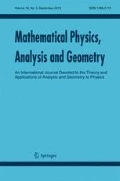Abstract
The existence (or not) of infinite clusters is explored for two stochastic models of intersecting line segments in \(d \geqslant 2\) dimensions. Salient features of the phase diagram are established in each case. The models are based on site percolation on \(\mathbb {Z}^{d}\) with parameter p ∈ (0,1]. For each occupied site v, and for each of the 2d possible coordinate directions, declare the entire line segment from v to the next occupied site in the given direction to be either blue or not blue according to a given stochastic rule. In the ‘one-choice model’, each occupied site declares one of its 2d incident segments to be blue. In the ‘independent model’, the states of different line segments are independent.
We’re sorry, something doesn't seem to be working properly.
Please try refreshing the page. If that doesn't work, please contact support so we can address the problem.
References
Aizenman, M., Grimmett, G.R.: Strict monotonicity of critical points in percolation and ferromagnetic models. J. Statist. Phys. 63, 817–835 (1991)
Athreya, K.B., Ney, P.E.: Branching Processes Grundlehren Der Mathematischen Wissenschaften, vol. 196. Springer-Verlag, Heidelberg (1972)
Barsky, D.J., Grimmett, G.R., Newman, C.M.: Percolation in half-spaces: equality of critical densities and continuity of the percolation probability. Probab. Theory Related Fields 90, 111–148 (1991)
Burton, R.M., Keane, M.: Density and uniqueness in percolation. Commun. Math. Phys. 121, 501–505 (1989)
Burton, R.M., Keane, M.: Topological metric properties of infinite clusters in stationary two-dimensional site percolation. Israel J. Math. 76, 299–316 (1991)
Chayes, L., Schonmann, R.H.: Mixed percolation as a bridge between site and bond percolation. Ann. Appl. Probab. 10, 1182–1196 (2000)
Daley, D.J., Ebert, S., Last, G.: Two lilypond systems of finite line-segments. Probab. Math. Stat. 36, 221–246 (2016)
Gandolfi, A., Keane, M.S., Newman, C.M.: Uniqueness of the infinite component in a random graph with applications to percolation and spin glasses. Probab. Theory Relat. Fields 92, 511–527 (1992)
Georgii, H.-O., Häggström, O., Maes, C.: The Random Geometry of Equilibrium Phases, Phase Transitions and Critical Phenomena, vol. 18, pp 1–142. Academic Press, London (2000)
Grimmett, G.R.: Percolation, Second Ed. Grundlehren Der Mathematischen Wissenschaften, vol. 321. Springer-Verlag, Berlin (1999)
Grimmett, G.R., Marstrand, J.M.: The supercritical phase of percolation is well behaved. Proc. Roy. Soc. London Ser. A 430, 439–457 (1990)
Häggström, O., Meester, R.: Nearest neighbor and hard sphere models in continuum percolation. Random Struct. Algor. 9, 295–315 (1996)
Hammersley, J.M.: Percolation processes: Lower bounds for the critical probability. Ann. Math. Statist. 28, 790–795 (1957)
Hilário, M., Ungaretti, D.: A note on the phase transition for independent alignment percolation. https://arxiv.org/pdf/2007.00539.pdf
Hirsch, C.: On the absence of percolation in a line-segment based lilypond model. Ann. Inst. Henri Poincaré, Probab. Statist. 52, 127–145 (2016)
Hirsch, C., Holmes, M., Kleptsyn, V.: Absence of WARM percolation in the very strong reinforcement regime. Annals of Applied Probability - to appear
Liggett, T.M., Schonmann, R.H., Stacey, A.M.: Domination by product measures. Ann. Probab. 25, 71–95 (1997)
Acknowledgements
NRB is supported by grant DE170100186 from the Australian Research Council. MH is supported by Future Fellowship FT160100166 from the Australian Research Council. The authors are grateful to a colleague and two referees for their comments.
Author information
Authors and Affiliations
Corresponding author
Additional information
Publisher’s Note
Springer Nature remains neutral with regard to jurisdictional claims in published maps and institutional affiliations.
Rights and permissions
About this article
Cite this article
Beaton, N.R., Grimmett, G.R. & Holmes, M. Alignment Percolation. Math Phys Anal Geom 24, 3 (2021). https://doi.org/10.1007/s11040-021-09373-7
Received:
Accepted:
Published:
DOI: https://doi.org/10.1007/s11040-021-09373-7

